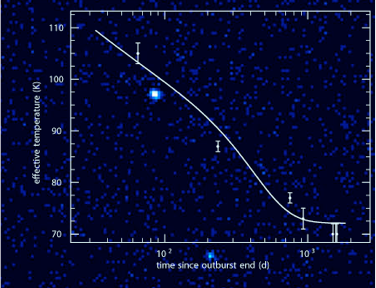
The background to this figure is an X-ray image, taken with Chandra, of the accreting neutron star KS 1731-260. In the foreground is a plot showing the measured surface temperature of the neutron star as a function of time since the accretion halted (Cackett et al. 2006). Comparing these observations with the superposed theoretical curve allows JINA researchers to infer the temperature and structure of the neutron star’s crust.
Image credit: NASA/CXC/Wijnands et al. Overlay plot from Brown & Cumming (2009).
Cooling Neutron Star Crusts
In 2001, the accreting neutron star KS 1731-260 abruptly went into quiescence, meaning that accretion of matter onto the neutron star halted. In quiescence, the hot neutron star photosphere emits X-rays with a thermal spectrum. Rutledge et al. had predicted that the cooling of the hot outer layers of the neutron star would be detectable in the years following the cessation of accretion. (During accretion, nuclear reactions are induced in the neutron star’s crust and heat the outer layers.) Follow-up observations by Cackett et al. have indeed discovered that the neutron star has dimmed and become lower in energy, as expected if the crust of the neutron star were cooling back into thermal equilibrium with the core. Since that time, several other neutron stars have exhibited similar behavior. JINA researchers Edward Brown (Michigan State University) and Andrew Cumming (McGill University) have constructed models of the neutron star crust, and used those models to fit the observed lightcurves (effective temperature as a function of time, as shown in the Figure). Brown and Cumming confirm previous calculations, by Shternin et al., that the thermal conductivity in the crust is rather high, as if the ions in the crust were arranged in a locally pure lattice. A surprise is the rapid decline in the first year of quiescence. Such a rapid decline would imply that the low density region of the crust is much hotter than predicted by standard models of nuclear reactions in the crust, and may point to the existence of an unidentified source of heating. Observations during the first fortnight of quiescence are critical for confirming whether this heat source in fact exists.